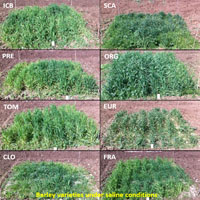Salinity tolerance evaluation of barley germplasm for marginal soil utilization

Accepted: 25 May 2021
Appendix: 65
HTML: 56
All claims expressed in this article are solely those of the authors and do not necessarily represent those of their affiliated organizations, or those of the publisher, the editors and the reviewers. Any product that may be evaluated in this article or claim that may be made by its manufacturer is not guaranteed or endorsed by the publisher.
One greenhouse experiment was conducted to assess the tolerance to salinity and water deficit stresses of 184 barley varieties (breeding lines or registered varieties). Also, a 2-year field experiment was conducted to evaluate the growth and yield components of 16 of these varieties, representing tolerant, intermediate tolerant and susceptible ones, grown simultaneously in saline and nonsaline soils. In the greenhouse, the K-means cluster analysis shown that 17 varieties were tolerant, 72 varieties intermediate tolerant, 16 varieties intermediate susceptible and 79 varieties susceptible. In the field, soil salinity reduced the germination of the barley varieties except for the varieties ICB 100126, Scarlett and Meteor. Barley varieties grown in the saline soil produced 33.2-to 83.4% lower dry biomass, 0.0-to 78.9% fewer ears and 0.0-to 81.5% lower grain yield than those of varieties grown in the nonsaline soil. In the saline soil, the greatest grain yield was provided by the vars. Galt Brea ‘S’ and ICB 100126 (4.87 and 4.31 t ha–1, respectively), without significant differences between saline and non-saline soils. In most barley varieties, chlorophyll content and photosystem II quantum yield were greater under saline than under non-saline conditions. The results of this research indicated that, in barley germplasm, a remarkable genetic variation exists which would contribute to barley production in saline soils.
Highlights
- The salinity tolerance of 184 barley varieties was investigated.
- There was great variability to salinity tolerance among barley germplasm.
- There were barley varieties which grown in saline soil without significant yield reduction.
- Barley could be an alternative crop system in soils with increased salinity.
How to Cite

This work is licensed under a Creative Commons Attribution-NonCommercial 4.0 International License.
PAGEPress has chosen to apply the Creative Commons Attribution NonCommercial 4.0 International License (CC BY-NC 4.0) to all manuscripts to be published.

 https://doi.org/10.4081/ija.2021.1830
https://doi.org/10.4081/ija.2021.1830







